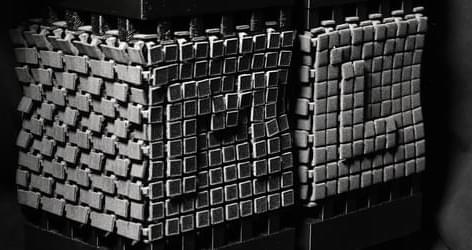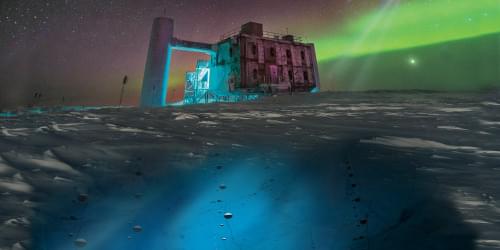A new tool can determine whether a collection of building blocks will assemble into a mechanically sound structure.




In 1911, physicist Heike Kamerlingh Onnes used liquid helium—whose production method he invented—to cool mercury to a few kelvins, discovering that its electrical resistance dropped to nil. Although mercury was later found to be a “conventional” superconductor, no microscopic theory so far managed to fully explain the metal’s behavior and to predict its critical temperature TC. Now, 111 years after Kamerlingh Onnes’ discovery, theorists have done just that. Their first-principles calculations accurately predict mercury’s TC but also pinpoint theoretical caveats that could inform searches for room-temperature superconductors [1].
Mercury is an exception among conventional superconductors, most of which can be successfully described with state-of-the-art density-functional-theory methods. To tackle mercury’s unique challenges, Gianni Profeta of the University of L’Aquila, Italy, and colleagues scrutinized all physical properties relevant for conventional superconductivity, which is mediated by the coupling of electrons to phonons. In particular, the researchers accounted for previously neglected relativistic effects that alter phonon frequencies, they improved the description of electron-correlation effects that modify electronic bands, and they showed that mercury’s d-electrons provide an anomalous screening effect that promotes superconductivity by reducing Coulomb repulsion between superconducting electrons. With these improvements, their calculations delivered a TC prediction for mercury only 2.5% lower than the experimental value.
The new understanding of the oldest superconductor will find a place in textbooks but may also offer valuable lessons for superconductivity research, says Profeta. A promising material-by-design approach involves “high-throughput” computations that screen millions of theoretical material combinations to suggest those that could be conventional superconductors close to ambient conditions. “If we don’t include subtle effects similar to those relevant for mercury, these computations may overlook many interesting materials or err in their critical temperature predictions by hundreds of kelvins,” he says.

“This represents a significant source of PFAS in the home environment,” said Sydney Evans, a science analyst with the EWG.
PFAS, or per-and polyfluoroalkyl substances, are a class of about 12,000 compounds used to make products resist water, stains and heat. They’re called “forever chemicals” because they don’t naturally break down, accumulating in humans and animals. PFAS are linked to a range of serious health problems like cancer, birth defects, kidney disease and liver disease.
The chemicals are likely used in pet food bags to make them repel grease. For cats, the highest levels were detected in the Meow Mix Tender Centers salmon and chicken flavors dry cat food, at more than 600 parts per million (ppm). Purina Cat Chow Complete chicken showed over 350 ppm, while Blue Buffalo, Iams and Rachael Ray Nutrish all had levels of less than 100 ppm.
Gallery QI — Becoming: An Interactive Music Journey in VR — Opening Night.
November 3rd, 2022 — Atkinson Hall auditorium.
UC San Diego — La Jolla, CA
By Shahrokh Yadegari, John Burnett, Eito Murakami and Louis Pisha.
“Becoming” is the result of a collaborative work that was initiated at the Opera Hack organized by San Diego Opera. It is an operatic VR experience based on a Persian poem by Mowlana Rumi depicting the evolution of human spirit. The audience experiences visual, auditory and tactile impressions which are partly curated and partly generated interactively in response to the player’s actions.
“Becoming” incorporates fluid and reactive graphical material which embodies the process of transformation depicted in the Rumi poem. Worlds seamlessly morph between organic and synthetic environments such as oceans, mountains and cities and are populated by continuously evolving life forms. The music is a union of classical Persian music fused with electronic music where the human voice becomes the beacon of spirit across the different stages of the evolution. The various worlds are constructed by the real-time manipulation of particle systems, flocking algorithms and terrain generation methods—all of which can be touched and influenced by the viewer. Audience members can be connected through the network and haptic feedback technology provides human interaction cues as well as an experiential stimulus.
While the piece is a major artistic endeavor, it also showcases a number of key technologies and streaming techniques for the development of musical content in XR. The spatialization system Space3D, developed at Sonic Arts and implemented to run on advanced GPUs, is capable of creating highly realistic spatial impressions, and recreating the acoustics of the environment based on the virtual models in real-time using advanced multi-processing ray-tracing techniques.
“Becoming” premiered at SIGGRAPH 2022, Immersive Pavilion in Vancouver, Canada in August 2022. Opera America and San Diego Opera showcased an early preview of this work as part of the first Opera Hack presentations in 2020.
One small step for a machine… one giant leap for the singularity.
This AI actually improved a key algorithm that makes it run even faster.
In this video I discuss new Deepmind’s AlphaTensor algorithm and why this work is so important for all the fields of Engineering!
Deepmind’s paper “Discovering faster matrix multiplication algorithms with reinforcement learning”:
https://www.nature.com/articles/s41586-022-05172-4
My Gear:
Dr. Michael Rose is an evolutionary biologist and authority in gerontology. His many years of research and keen insight establish unique methods to frame the problems of aging. Michael made scientific history with experiments manipulating the life spans of fruit flies. As a pragmatist, Michael sees beyond today’s quick fixes to examine what could be the most important changes in the longevity industry to slow down and stop aging. His view is that genomics in conjunction with machine learning is the future of longevity.

From swerving to sheltering in place, here’s how the International Space Station handles hazards on the increasingly cluttered space lanes.
The most recent maneuver happened last week when the ISS boosted itself into a higher orbit to avoid debris from a 2021 Russian anti-satellite missile test. It’s likely that such close calls will only get more common as humanity keeps cluttering up the space lanes with old satellites and bits of wreckage from collisions and missile tests. Here’s what you need to know about space debris and how to avoid it.
How does the International Space Station dodge space debris?
It’s tempting to picture astronauts piloting the ISS like it’s the Millennium Falcon, relying on their lightning reflexes (and maybe the Force) to swerve around bits of obliterated spaceships, often with mere inches to spare. The reality — like a lot of things in space flight — is much slower and happens over much bigger distances than Hollywood’s version. But it can still be extremely tense, as lives are at stake, and if something goes wrong, help is not on the way.
Let’s hangout and recap some of our most watched What If scenarios.
Get our 100 best episodes in one mind-blowing book: http://bit.ly/ytc-the-what-if-100-book.
Watch more what-if scenarios:
Planet Earth: http://bit.ly/YT-what-if-Earth.
The Cosmos: http://bit.ly/YT-what-if-Cosmos.
Technology: http://bit.ly/YT-what-if-Technology.
Your Body: http://bit.ly/YT-what-if-Body.
Humanity: http://bit.ly/YT-what-if-Humanity.
T-shirts and merch: http://bit.ly/whatifstore.
Suggest an episode: http://bit.ly/suggest-whatif.
Newsletter: http://bit.ly/whatif-newsletter.
What If elsewhere:
Instagram: http://bit.ly/whatif-instagram.
Discord: https://discord.gg/Bj5UnspbwE
Twitter: http://bit.ly/whatif-twitter.
Facebook: http://bit.ly/facebook-whatif.
What If in Spanish: http://bit.ly/YT-Spanish-what-if.
What If in Mandarin: http://bit.ly/YT-Chinese-what-if.
Podcast: http://bit.ly/yt-what-if-show-podcast.
What If is a mini-documentary web series that takes you on an epic journey through hypothetical worlds and possibilities. Join us on an imaginary adventure through time, space and chance while we (hopefully) boil down complex subjects in a fun and entertaining way.
Personal computing has gotten smaller and more intimate over the years—from the desktop computer to the laptop, to smartphones and tablets, to smart watches and smart glasses.
But the next generation of wearable computing technology—for health and wellness, social interaction and myriad other applications—will be even closer to the wearer than a watch or glasses: It will be affixed to the skin.
On-skin interfaces—sometimes known as “smart tattoos”—have the potential to outperform the sensing capabilities of current wearable technologies, but combining comfort and durability has proven challenging. Now, members of Cornell’s Hybrid Body Lab have come up with a reliable, skin-tight interface that’s easy to attach and detach, and can be used for a variety of purposes—from health monitoring to fashion.